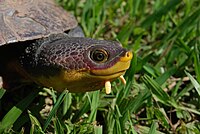
Population structure of a widespread bat (Tadarida brasiliensis) in an island system
Sign Up to like & getrecommendations! Published in 2017 at "Ecology and Evolution"
DOI: 10.1002/ece3.3233
Abstract: Abstract Dispersal is a driving factor in the creation and maintenance of biodiversity, yet little is known about the effects of habitat variation and geography on dispersal and population connectivity in most mammalian groups. Bats… read more here.
Keywords: bat tadarida; population structure; brasiliensis; population ... See more keywords

Differential Analysis of Mycelial Proteins and Metabolites From Rigidoporus Microporus During In Vitro Interaction With Hevea Brasiliensis.
Sign Up to like & getrecommendations! Published in 2021 at "Microbial ecology"
DOI: 10.1007/s00248-021-01757-0
Abstract: Rigidoporus microporus is the fungus accountable for the white root rot disease that is detrimental to the rubber tree, Hevea brasiliensis. The pathogenicity mechanism of R. microporus and the identity of the fungal proteins and… read more here.
Keywords: proteins metabolites; hevea brasiliensis; analysis; rigidoporus microporus ... See more keywords

Spatio-temporal variation and the use of host body surface by ectoparasites of the chelonians Phrynops geoffroanus and Mesoclemmys tuberculata in areas of the Caatinga and Atlantic Forest in northeast Brazil
Sign Up to like & getrecommendations! Published in 2019 at "Parasitology Research"
DOI: 10.1007/s00436-019-06208-x
Abstract: Ectoparasites such as hematophagous leeches and monogeneans are common in chelonians, occupying different parts of the body. Thus, the present study aimed to identify and describe the fauna of ectoparasites that infest Phrynops geoffroanus and… read more here.
Keywords: atlantic forest; mesoclemmys tuberculata; phrynops geoffroanus; caatinga atlantic ... See more keywords

Complete genome sequence of a novel capillovirus infecting Hevea brasiliensis in China
Sign Up to like & getrecommendations! Published in 2019 at "Archives of Virology"
DOI: 10.1007/s00705-019-04459-8
Abstract: Tapping panel dryness (TPD) is a complex disorder that causes partial or complete cessation of latex drainage upon tapping of rubber trees ( Hevea brasiliensis ). In this work, we determined the complete genome sequences… read more here.
Keywords: genome sequence; hevea brasiliensis; complete genome; brasiliensis ... See more keywords

Genetic evidences of non-reproductive shoaling in the freshwater fish Salminus brasiliensis
Sign Up to like & getrecommendations! Published in 2018 at "Hydrobiologia"
DOI: 10.1007/s10750-018-3550-y
Abstract: Recent studies have identified patterns of genetic organization during schooling in the reproductive period of several Neotropical freshwater migratory fish. However, population segregation during non-reproductive periods is still unknown for most species. In this study,… read more here.
Keywords: freshwater fish; salminus brasiliensis; brasiliensis; non reproductive ... See more keywords

The Critical Role of Notch1–TLR 4 Signaling in the Inflammatory and Fungicidal Activity of Macrophages Against Paracoccidioides brasiliensis Strain Pb18
Sign Up to like & getrecommendations! Published in 2017 at "Mycopathologia"
DOI: 10.1007/s11046-017-0154-4
Abstract: Paracoccidioidomycosis is a systemic mycosis of deep nature that primarily affects the lung and can spread via lymphatic and hematogenous to other organs and tissues. It is mainly caused by Paracoccidioides brasiliensis fungus which exhibits… read more here.
Keywords: receptor; strain; brasiliensis; notch1 ... See more keywords

Characterization and potential strategies for the valorisation of the Southwest Atlantic butterfish (Stromateus brasiliensis)
Sign Up to like & getrecommendations! Published in 2020 at "Journal of Food Science and Technology"
DOI: 10.1007/s13197-020-04332-6
Abstract: The waste of fish resources constitutes a serious environmental problem that must be avoided. The valorisation of by-catch species and decreasing the discard rate constitute a more efficient and sustainable use of these marine biomasses.… read more here.
Keywords: strategies valorisation; valorisation southwest; brasiliensis; characterization potential ... See more keywords

Preparation of nanocellulose from Imperata brasiliensis grass using Taguchi method.
Sign Up to like & getrecommendations! Published in 2018 at "Carbohydrate polymers"
DOI: 10.1016/j.carbpol.2018.03.055
Abstract: Cellulose nanoparticles (CNs) were prepared by acid hydrolysis of the cellulose pulp extracted from the Brazilian satintail (Imperata Brasiliensis) plant using a conventional and a total chlorine free method. Initially, a statistical design of experiment… read more here.
Keywords: imperata brasiliensis; grass; using taguchi; brasiliensis ... See more keywords

Toxic effects of ornamental stone processing waste effluents on Geophagus brasiliensis (Teleostei: Cichlidae).
Sign Up to like & getrecommendations! Published in 2019 at "Environmental toxicology and pharmacology"
DOI: 10.1016/j.etap.2019.103268
Abstract: The ornamental stone industry generates considerable amounts of waste (OSPW), which may eventually reach natural environments and impact the local ecosystem. The aim of this study was to compare the toxic effects of two OSPW… read more here.
Keywords: ornamental stone; waste; effluents geophagus; toxic effects ... See more keywords

A galactomannoglucan derived from Agaricus brasiliensis: Purification, characterization and macrophage activation via MAPK and IκB/NFκB pathways.
Sign Up to like & getrecommendations! Published in 2018 at "Food chemistry"
DOI: 10.1016/j.foodchem.2017.06.152
Abstract: In this study, a novel galactomannoglucan named as TJ2 was isolated from Agaricus brasiliensis with microwave extraction, macroporous resin, ion exchange resin and high resolution gel chromatography. TJ2 is composed of glucose, mannose and galactose… read more here.
Keywords: brasiliensis purification; derived agaricus; galactomannoglucan derived; agaricus brasiliensis ... See more keywords

CRISPR/Cas9-mediated genome editing in Hevea brasiliensis
Sign Up to like & getrecommendations! Published in 2021 at "Industrial Crops and Products"
DOI: 10.1016/j.indcrop.2021.113418
Abstract: Abstract Clustered regularly Interspaced Short Palindromic Repeats/CRISPR associated protein 9 (CRISPR/Cas9) has not been completely established in Hevea brasiliensis. In the present study, firstly, five endogenous U6 promoters from H. brasiliensis were identified and exploited… read more here.
Keywords: hevea brasiliensis; genome editing; brasiliensis; crispr cas9 ... See more keywords